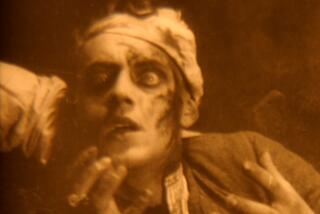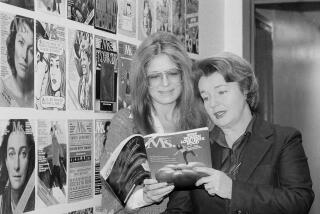The smell of ink, the thrill of testosterone
- Share via
The men’s magazines surveyed in Adam Parfrey’s “It’s a Man’s World” had their effulgence during the first long leg of the Cold War. Their evolution, reflected in the feverishly vivid illustrations Parfrey has assembled, is readily linked to notions of masculinity that seemed firmly in place throughout World War II and embattled ever after. The decay of certainty, the sense of ideological threat that accompanied the postwar economic boom, the mutation of the GI into the man in the gray flannel suit summoned a nostalgia for an unambiguous manliness expressed in violent action and a longing for coherent adversaries in a world in which enemies were increasingly faceless and prosperity had a curious resemblance to zombie-ism.
The staples of publications like Argosy, Peril, Sir, Fury, Male, Men Today, All Man, Real Men, Men in Conflict, Man’s Adventure and dozens of similar titles -- sadistic Nazis, menacing wildlife, headhunting natives of voodoo islands, marauding Apaches, killer Communists -- express in lurid, living color the deep wish for a morally and sexually black-and-white world. Masculinity is defined by the testing ordeal. The protagonist is typically pitted in grossly unequal, unfair combat against implacable, monstrous enemies. The comic book cousins of these magazines show evil reliably vanquished by superhuman heroes. The men’s magazines suggest the possibility of unhappy or incomplete outcomes: Threats are so myriad and multifarious that the price of security is eternal vigilance, eternal grimacing, scowling and cowering.
The extreme depictions of danger the pulps trafficked in carry a freight of dread more evocative of moral twilight than triumphalism. The pictorial style on view here is virtually the same melodramatic rendering of “the dark side” associated with film noir and the early paperback novel. The iconography is one of pure immanence. The moment most often captured on these magazine covers is one in which the menaced subject has already slogged through a snake-infested swamp, been tortured in a Nazi prison camp, washed up on the shores of a cannibal island and now, in torn or shredded clothing, sopping wet or desiccated after crawling through a desert, faces decapitation, consumption by vicious marine life, amputation by hacksaw, attack by alligators, weasels, ferrets, Indian arrows or samurai cutlasses, sexual exhaustion by Nazi libertines, cigar torture at the hands of Fidel Castro and sometimes -- not often -- incineration by H-bomb.
The yearning for an ennobling mythos embodied in this canon of popular art had a furtive aspect. These were not the magazines that went on the coffee table, and the fact that they were “gendered,” just as Redbook and other women’s magazines were, assimilated them into the loose orbit of soft-core pornography. In their time, testosterone was perceived as such a volatile and vulgar quantity that home and family life were designed to “contain” it, siphoning chaotic energies into productive, uniform channels. Yet it was well understood, in the suburban dream homes of the 1950s, that the male essence was prone to spillage and explosion; the rituals of postwar marriage included the male’s periodic defection from the nest, in the form of cocktail party brawls or fishing and hunting trips.
For many decades now, popular and political culture has promoted a fantasy of the 1950s as a long idyllic moment when family life, gender roles and moral values were fixed in utopian perfection. Yet it is clear from the subliterature surveyed by “It’s a Man’s World” that at least half the gender equation was deeply troubled by the restraints of domestic life and felt most energized and fully alive imagining situations of mortal peril and physical combat, ones that included supine and often half-dead female bodies in urgent need of rescue or whip-wielding vixens to be overpowered and tamed. A restive, neurotic quality slips into the mix in publications like Dare, Exposed, Crime Confessions and the like, in which the men’s adventure sensibility is brought to bear on contemporary life in America. The same tropes of deadly exotic menace, applied to the landscape of middle-class domesticity, reveal the social schizophrenia of an idealized era.
Along with their characteristic obsession with sex as a pointedly underdescribed, lavishly prefigured mating of hunters and gatherers, the men’s magazines devoted to subjects closer to home than saber-toothed tiger attacks or “Teen Terrors of the Tamiami Trail” suggest the suffocating, panic-stricken undercurrent of American conformity, in features like “What Are Your Homosexual Tendencies?” and “How to Tell if Your Girlfriend Is a Lesbian.” The racial tensions roiling under the era’s apple pie crust erupt in both the Photoplay type of Hollywood item (“Joan Fontaine and Her Negro Screen Lover Court Racial Explosion!”) and more directly libidinal, generic articles (“The Interracial Sex Experimenters”) whose illustrations stimulated the miscegenative impulses the articles decried or condemned.
“It’s a Man’s World” features several interviews with, and reminiscences by, the people who labored on the pulp magazines in their glory days, including Bruce Jay Friedman and Mario Puzo. The world of the pulps was simply a venue where some writers could make a decent, if frantic living, rather than a deliberate engine of ideology or politics; the magazines’ fortunes rose and fell according to the public mood; their stories usually had some loose relationship to documentary reality and arguably a stronger relationship to cinema than literature. Often a powerful illustration became the occasion for a story rather than the other way around. Speed of production was everything. There was a wealth of retrograde, stereotypical bromides embedded in the pulps, and the impetus was simply to entertain the escapist fantasies of a grimly stratified, imaginatively constipated, lethally conformist era, continually recycling whichever stock villains, deadly threats, sexual innuendoes and combat paraphernalia had proved their appeal at the newsstand.
The writers themselves attest to having no idea who the readers of these magazines were, though they sold in huge quantities; the decline of the men’s adventure pulp appears to have been steady throughout the 1960s, its audience eroded by hybrid high-lowbrow offerings like Playboy, reaching a nadir during the Vietnam War, which none of the pulps rendered in an appealing way.
“It’s a Man’s World” deserves a companion survey of the contemporaneous “middlebrow” literature of disaster: novels such as “Alas! Babylon,” “On the Beach,” “A Canticle for Leibowitz” and other works in which the nuclear threat was terrifyingly manifested as fait accompli. When we recall the role of paranoia in the construction of normality during the Cold War, the men’s adventure magazine becomes an artifact of considerable charm, providing scenarios of the individual fighting formidable but legible adversaries against daunting but not impossible odds. If the pulps looked back to a just war of improving sacrifice or an earlier time of struggle against nature, the nuclear fiction of the period looked to a future of moral relativism, ecological catastrophe, political incoherence and the all too plausible extinction of everything.
More to Read
The biggest entertainment stories
Get our big stories about Hollywood, film, television, music, arts, culture and more right in your inbox as soon as they publish.
You may occasionally receive promotional content from the Los Angeles Times.










